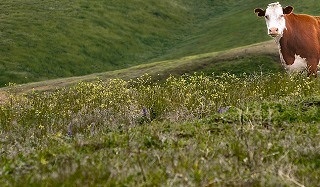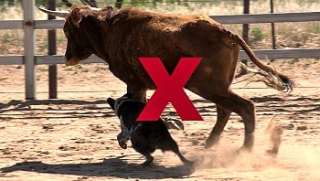The Seven Rules for Producing Great Beef: 1 2 3 4 5 6 7
The Stickiness of Livestock Stress

Image Credit: Bala Sivakumar, Flickr, CC BY 2.0
In Rules 4 and 5 of the Seven Rules of Producing Great Beef I showed how livestock stress affects beef tenderness and flavor. I explored a wide range of factors that cause cattle to experience stress, including environmental stresses, social stress, disease and injury, handling stress, and nutritional stresses.
However, stress doesn’t just melt away just because the cause of the stress is gone.
Stress takes time to fade away; weeks, months, even years depending on the type of livestock stress, how severe it was, and how long it persisted. And it doesn’t really matter what kind of stress it is - stress is stress, regardless of source. Stress is sticky.
The bottom line is that livestock stress in your cattle herd today isn’t going to disappear by tomorrow even if the reason for it has been resolved. It may even continue to haunt your cattle right through to the slaughterhouse and until their beef reaches your customer’s barbeque, which is why it is so important to be aware of the many causes of livestock stress and how to prevent them at all stages of the production process, from cow-calf right through to the butcher shop.
(Rule # 6)
Livestock stress is 'sticky' - the effects of stress can last weeks or even months after the initial cause of stress is resolved.
Why are the effects of stress so persistent?
There are a number of reasons related to why the effects of livestock stress last so long after the cause of the initial stress has long passed. It is part psychological, part biochemical, and part survival instinct.
Let's start with the chemistry - the adrenaline discussed in Rule # 4.
Adrenalin heightens memory. It is the chemical agent used by the body to trigger the creation of long-term memories. In effect, adrenalin provides the glue in the brain to capture the memory of important events and hold onto them for extended periods of time.
Normal events through our awareness, but as soon as something triggers a burst of adrenaline, events passing through our awareness suddenly become sticky and get stuck in the memory bank for future reference.
Boring events are not important. Survival depends on remembering important events (where the danger is located, where the waterhole is, where to find the gate that releases the cattle into the next pasture).
Essentially, anytime there is fear, excitement, or an emotional extreme, a release of adrenalin will be triggered. This is why adrenalin and memory are so closely interlinked, adrenalin allows our brains to prioritize what events are important to remember for our survival, and what events can be allowed to fade because they are unimportant.
Without adrenalin we’d be overwhelmed by every little detail in our memory and wouldn’t be able to sort through what was significant and what was not. And since a cow has a much smaller brain processing capacity than we do, this memory sorting process provided by adrenaline is even more important!
Adrenaline plays the same role in the brains of all mammals,
including cattle and humans. This is why our memory is composed of
highlights - the emotional extremes - when we were scared, happy, sad,
in pain, suffering, or overcome with joy. You can blame (or thank)
adrenalin for why you don’t remember the details of brushing your teeth
on June 12th, 1993, but you can vividly remember every single moment of a
car crash, first date, or frightening wildlife encounter. It is also
why old people always remember how much better it was back in the good
old days because their memory is composed of all the highlights of their
life when their adrenalin was high, while having forgotten all the
dull, boring, or mildly annoying bits that failed to trigger a strong
enough emotional response to release enough adrenalin to help the brain
remember that part of their history.
Consequently, when stressful events happen to our cattle, the memory of that event stays with them.
And as you can probably relate from your own experiences, whenever we remember a stressful event, it produces a brand new rush of adrenaline, which further reinforces the initial memory.
|
The memory of fear, anguish, pain, or suffering stays with our cattle, reinforced by fresh bursts of adrenaline triggered simply through the act of remembering! Memory (glued into the brain by adrenaline) only fades slowly and only if there are no further actual recurrences of whatever caused the memory in the first place. The memory of a single crashing gate or a cattle prod may be persistent enough, but that memory gets stickier and stickier if it is reinforced by fresh similar events happening over and over again. The greater the initial livestock stress, or the more frequently it occurs, the greater the impact it has on the cattle’s memories and therefore the longer it takes to fade away. |

|
The adrenalin produced during a stressful event heightens the importance of that memory in relation to everything else. In essence, it takes a lot of time and gentle caresses to fully get over a painful slap across the face.
If the memory remains, however faint, then the stress of
that event remains, however faint, in the form of hyper-vigilance,
nervousness, and more adrenaline production, which in turn continues to
make muscles tight and meat tough, and continues to deteriorate the beef
flavor. It’s a nasty vicious circle.
Not all livestock stress comes from
conscious memories. Adrenalin is released by the body to prepare the
animal to fend off threats, both conscious threats and subconscious
ones. Consequently, even a subtle nutritional stress or disease that
does not produce a significant memory is still recognized by the body as
a threat because the animal does not feel good. When an animal does not
feel right, it automatically starts producing extra adrenalin, which in
turn causes the animal’s muscles to tense up and increases its
awareness of its surroundings (nervousness = vigilance). This is an
instinctive protective mechanism to protect sickly, malnourished, or
injured animals from further injury or predators.
Being nervous for a long period of time after a stressful event helps the
animal stay out of danger by making it more aware of its surroundings.
It is in the animal’s best survival interests to hang onto stress;
precisely the opposite of what the farmer wants when he or she is
raising cattle for beef...
From an evolutionary point of view,
having a survival mechanism that increases vigilance while the animal is
vulnerable protects them from falling into the same danger twice. If
cattle can remember past stressful events, they can learn from them. An
adrenalin charged memory of what a wolf’s ears look like hunkered down
behind a tall clump of grass ensures that the wolf won’t be able to fool
them twice in a row.
This mechanism also allows cattle to remember the particularly choice parts of the pasture or where the water hole is located. The adrenalin triggered during a heightened emotional response (fear, happiness, joy, pain) is an essential ingredient in learning; being able to retain what actions provided a good or bad consequence is extremely important so the animal can either do it again tomorrow or can avoid repeating that action like the plague.
But
while stress helps our cattle learn to stay out of harm’s way, it also
reduces our eating pleasure when we eat beef from a stressed animal.
Calm, relaxed, slightly bored but happy cattle with very repetitive and
uneventful routines will be the most tender beef when they finally reach
your barbeque.
A culture of livestock stress in the herd...

Image Credit: Donnie Rae Jones, Flickr, CC BY 2.0

Image Credit: Donnie Rae Jones, Flickr, CC BY 2.0
Livestock stress can even create its own self-reinforcing culture within a cattle herd where nervous, high-strung individuals infect one another with their nervousness.
Again there’s an evolutionary advantage. If another animal is nervous or fearful, it is better to also become nervous and fearful as well rather than waiting until you also see the wolf with your own eyes. By then it may be too late. React first, think later - basic survival mechanism. It’s better to overreact 10 times than to be complacent even once in the face of real danger. Hence, the infectiousness of stress in a herd.
This infectiousness of livestock stress creates bad behavioral habits in your herd that are passed on from generation to generation, like rushing headlong through gates as soon as they are opened or panicking about a food shortage as soon as the first flake of snow falls in the winter.
Herd animals tend to imitate whoever reacts first. So, if the leader always bolts then the followers learn to always bolt too - that’s just what you do if you want to stay within the protective envelop of the herd. Thus, stress can become a habit in the herd and may not have anything to do with what the herd is actually experiencing. It’s just part of the herd culture...
Unfortunately, reacting first and thinking later (or not at all) is why learned behaviors (learned stress triggers) can become completely disconnected from the initial livestock stress that caused these behaviors to develop in the first place. And this group-think is not just restricted to cattle - this is how stock market bubbles form, religious cults develop and how gangs work. The individuals within the herd get swept up by the behaviour of the group and put aside their own behavioral filters and common sense.
From a survival perspective it is statistically better to be rushing off in the wrong direction with the entire herd than to be right, but standing all alone and exposed to the wolves.
Once stressful behaviors become part of a herd’s typical behaviour pattern, they must be actively unlearned or culled from the herd by your management strategy.
You actively have to cull nervous herd leaders.
You have to retrain the herd to walk instead of run through the gate.
You will need a strategy to actively replace the negative group-think in your herd with a new behavioral pattern - new habits - otherwise the momentum of the herd’s learned behavioral patterns will simply repeat and reinforce the same behaviors over and over and over again. And, like all bad habits, it is very easy for a herd of cattle to relapse into unwarranted stressful behaviour patterns or adrenalin-filled responses pattern as new situations arise that trigger old memories and bad behaviour patterns.
Stress prevention, while the slate is still clean, is always easier than curing a legacy of stress in your cattle herd. And if your herd already has adopted a culture of stress, you need to be very proactive to remove it and create new habits. The reputation of your beef is on the line!
The Cumulative Build-Up of Stress
Stresses build upon one another. Cattle, like all animals (and people) are typically very resilient to a single stress event. If a wolf wanders through the herd and upsets the herd to the point of hysteria, but then leaves, within a few hours the herd has settled down as if nothing ever happened. End of story.
But... if that wolf comes back again tomorrow, and the day after, the stress levels within the herd stay increasingly elevated as fear and watchfulness increase, thus magnifying and greatly extending the length of time that the herd will remain stressed.
Likewise, if you are handling cattle in the corral and a metal panel falls over with a loud crash, it will temporarily scare the living daylights out of the entire herd. But, if you let the herd settle down for 20 minutes or so before resuming any activities in the corral, stress levels within the corral will simmer down almost to the same level as before the loud frightening crash. End of story.
But... knock that metal panel over a couple more times, add some loud shouting, a barking dog, or a cattle prod to the mix, or fail to let the herd settle down after the initial excitement, and that herd will not only stay extremely agitated throughout the remainder of the day, but that stress will follow them for weeks out on the pasture, and a fresh wave of stress will be triggered even months later just by re-entering the same corral, before anything new has even happened.
In other words, livestock stress adds up like drops in a bucket. A single drop evaporates quickly, but if the drops accumulate, you quickly reach a point where the stress grows faster than it can evaporate, the bucket will fill and overflow, and then it will take a very long time to fade away. The sum of combined stresses is far more important than any single isolated stress.
Anyone who has had a massage knows how stress is stored in muscle knots for weeks or months after a stressful experience, and how stressful situations from your past can create long-reaching stress responses and elevated stress levels months and even years after the initial cause of the stress is long gone.
Consider how people who have experienced food shortages in their past often still have unhealthy (stressful) hang-ups around food many decades later, such as not being able to relax until the last piece of the cake on the counter has been polished off. Or children who were beaten badly still flinch decades later when they are fully grown adults if a raised hand or unidentified shadow unexpectedly approaches them from the side. Or consider how persistent post-traumatic stress disorder is among many soldiers who have spent time on the front lines.
When we look at stress from our own experiences, it is easy to relate to why stress is so persistent among our cattle long after the initial cause of the stress is long past, and why it is so important to actively work to reduce livestock stress in your grazing and grass-finishing programs.
A lesson about livestock stress, from Kobe, Japan...
The Japanese created a world-renowned beef, called 'Kobe beef' which is famous for its tenderness and flavor. The attention to detail that goes into every aspect of the cattle's lives to meet the high standards set to qualify as Kobe Beef are quite remarkable. Legend even has it that they began massaging their cattle to work all the tension out of the muscles.
While the cattle massages may well be an urban myth, the tenderness and flavors of Kobe Beef are not. You can learn more about Kobe Beef at this travel writer's blog page.
Summarizing Livestock Stress in your Grass Finishing Program
Cattle are not that different from us in their response to stress, even if it takes a little more imagination on our part to understand how they can continue to feel stress on pasture, knee deep in grass, months after the memory of a traumatic or stressful experience has faded.
Cattle have memory just like we do, even if their processing power is only a fraction of our own. So it shouldn’t come as a surprise that they respond to stress in much the same way with raised alertness, raised adrenaline and frayed nerves.
And, like us, they also retain subconscious tension, hyper alertness, and nervousness long after the memories have faded, which further delays the fading of muscle tension and high adrenaline levels that affect the quality of our beef.
If livestock stress is left unchecked in your cattle herd, stressful events from years earlier will continue to haunt your cattle herd when create a legacy of stress that will taint the beef on your customers' plates.
If you are raising cattle for beef, remember to take the time to imagine how cattle perceive the world around them and understand their needs (nutritional, social, etc.) so you can design a suitable grazing program, handling protocol and management strategy for your cattle that minimizes stress as much as possible and replaces stressful memories and behavioral responses with new calm habits.
You can learn more about livestock stress, cow psychology, the audio-visual world of cattle, flight zones, and handling strategies that reduce cattle stress in my book, Grass-fed Cattle: how to produce and market natural beef.
Moving On...
And now for the final rule - Rule # 7 - of the Seven Rules of Producing Great Beef, which is all about how beef must be slaughtered and cooked in order to preserve all the tenderness and flavor that you produced in the pasture.
Even if everything has been done right up until this point, what happens in the slaughterhouse and kitchen will make or break the experience when the beef finally reaches your teeth and taste buds.
No matter what your level of cooking expertise is, Rule # 7 will provide you will some very important tips about cooking grass-fed versus grain-fed beef. These simple tips are extraordinarily easy and quick if you are aware of them, but will cause a lot of grief at the dinner table if you don’t know about them.
Continue to:
Related Articles:
(Disclosure: I get commissions for purchases made using Amazon links in my post.) And when you're ready to start planning your cattle farm, check out my book: Grass-Fed Cattle: How to Produce and Market Natural Beef. Use the links below to explore my book and read reviews on Amazon: 
|



